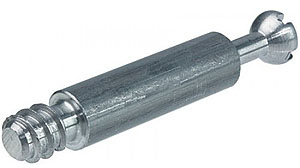Howdy folks.
I've always been a lover of pinball games. I'd say a "fan" but these days, a "fan" can imply that I'm a total walking pinball machine encyclopedia who knows everything there is to know about these mechanical wonders, goes to tournaments regularly, has an extensive pinball machine collection filling all rooms of my house, etc., etc. I neither have the money, the know-how to maintain, nor the space to own a real commercial-grade pinball machine. So for years I've had to spend quarters to play them, or play electronic simulations of machines on home video game consoles and computers (many of them are superb). It wasn't until some years ago, I spotted a scaled down home pinball machine at a local Best Buy. It was themed to the then-new theatrical release of Disney's
Pirates of the Caribbean: Dead Man's Chest. I was intrigued, and naturally, started to play. I immediately acknowledged its shortcomings, but also noticed how impressively designed it was, especially for what is essentially a toy. I don't quite remember the actual price tag but I figure it was around $299. Not bad, but I was pretty broke. Owning something like that was but a dream to not likely come true.
For the longest time I longed to have my very own pinball machine. Though due to the cost constraints, as well as space, I kept thinking about that little Pirates machine I saw back then at Best Buy. After a little research I found they were made by a company (now defunct) called Zizzle, a toy company who also held the license to produce many other Pirates toys. I also learned their pinball machines didn't sell very well and quickly were sold at reduced prices. Other models were offered, including a Marvel Comics themed version, a refreshed version for the next Pirates movie that followed (
At World's End), as well as a planned but ultimately scrapped Atari themed version.
More research yielded some interesting information on their construction, quality, and flaws. Many people hate them. Others love them. Others enjoy them for what they are, a small cheap alternative to a real pinball machine. Also, after discovering how a few resourceful folks began to modify their machines to their liking, fixing things here and there to make it more playable, I was immediately inspired. I saved up some dough and set on a mission to get one. Finally scored one of these babies on Craigslist for $200 in good shape.
Not being one to be content to simply keep the machine as it left the factory, I simply
had to do some modifications. Out of the box, I'll agree with most people who slam the machine with negative reviews, it's barely playable. Allow me to describe the most predominant issues these machines had that possibly ultimately killed what may have been a very successful product, as well as briefly describe what I did to fix these issues.
WEAK AND UNRESPONSIVE FLIPPERS:
This is perhaps the most egregious part of these machines. I found that you had to be very deliberate when pushing the buttons to get the flippers to go when you want them to, otherwise, they either don't respond, or are slow and weak. Most have blamed the relatively low voltage solenoids (12V). But after some testing I later discovered that the solenoids powering the flippers are in fact powerful enough to effectively move the ball around the small play field. What was seriously impacting their strength and sensitivity was the horrendous stock buttons that activates the flippers. They look like full-size arcade buttons but inside is actually a tiny and very unreliable momentary switch. Replacing these with actual arcade buttons made a world of difference. The flippers react instantly as they should, and the ball moves much faster across the play field.
CONSTANTLY DRAINING BALLS:
This part is puzzling, as this is technically geared at younger kids who are not pinball pros. It is one hard game to play. Take into account that despite the ball being smaller than a regulation pin ball, the space between the flippers is ridiculously wide. Adding a ball-save bumper in the right spot between the flippers levels the playing field (no pun intended).
Adding insult to injury, the out lanes (the lanes located on the far sides of the bottom of the machine, causing you to lose a ball) are also far too wide open. Adding a simple bumper to help divert the ball, while still allowing it to fall freely on either side, helped tremendously.
SPARSE PLAY FIELD:
This is a mostly cosmetic issue. This machine could have benefited from just a little more decor. Some more lighting and miscellaneous decals would have jazzed up the design. Subsequent models following this one addressed this issue. I took it upon myself to sculpt some items, design and add a few decals, etc. As of this writing I've yet to add any additional lighting.
On to the mods...





























